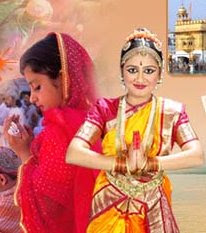Armenian Church is located in Armenian Street, at the north-west corner of Barabazaar, near Howrah Bridge in Kolkata. Some people opine that this is the oldest Church in Calcutta.
 |
| Armenian Church Calcutta Photo |
Built in 1764, designed in the early 18th century, the Armenian Church is today the oldest extant church in Kolkata. The interiors of the church are decorated with marble, and the overhead gallery contains mural tablets. The altar has a cross, the gospels and 12 candlesticks symbolizing Christ and his Apostles. There is a staircase leading to an overhead gallery whose walls are full of mural tablets. Three oil paintings 'The Holy Trinity', 'The Last Supper' and 'The Enshrouding of Our Lord’ by the English artist A E Harris also adorn the altar. Remains of the Armenian cemetery can be seen in the premises.
The Armenians have been staying in India since remote antiquity. The Armenians claim to have arrived in India before the British. They also claim to have been the forerunners to be converted into Christianity in the European continent. On 22nd June, 1688, the East India Co. had entered into a contract with the Armenians in Europe. Sir Josia Child on behalf of the East India Co. and Khoja Sarhad along with Khoja Phanoosh on behalf of the Armenians, signed the contract. As per the contract, the East India Co. was supposed to construct a church in all corners of India where a minimum of 40 Armenians would inhabit. The former would also grant 50 pounds to the appointed priest as his remuneration.
 |
| Armenian Church Photo |
According to this contract, Job Charnock came to Kolkata for the last time in 1690. 17 years later, the East India Co. constructed a tiny wooden church at the south-eastern wing of the present Armenian Church. A different opinion suggests that an Armenian named Aga Nazar had collected funds painstakingly and constructed this church.
Seventeen years later, the modern church came into being in 1724. It is said to have been built in the vacant land purchased in 1720 by an Armenian named Kenanentekh Phanoosh for building a cemetery for his community. But there is no controversy about the fact that this church was build by Aga Nazar. Controversies and conflicting views abound with one particular grave in this necropolis. This controversial grave is in front of the main building of the church. The following lines are engraved on the tomb – ‘This is the tomb of Reza bibi, wife of the late charitable Sookias who departed from this world to life eternal’. Another script is inscribed with this in Armenian language. There is a lot of controversy prevailing among the researchers about this Armenians Script. Mesrov Je Seth authored a book on the Armenians of Kolkata. He deciphered the script on the Armenian cemetery and apprised that the mentioned grave belonged to the period1630.
The interior embellishment of the church was done by katchik afriel. He was of Armenian origin. He built residential abodes for the priests and erected high walls around the cemetery. He also donated the wonderful church clock. The floor inside the church is made of blocks of stone. The spiraling stair-case leads to the gallery on the first floor. Armenian names are inscribed hither and tither. Beside the altar, there are three oil-paintings of the eminent English painter A.E. Harris which have an extremely soothing effect.
Quick information about Armenian Church
Location: Armenian Street, at the north-west corner of Barabazaar, near Howrah Bridge in Kolkata.
Time to Visit: 10 A.M. - 7 P.M.
Best Timings: Morning between 10 A.M - 11.30 A.M. & Evening between 3 P.M. - 5 P.M.
Admission Fee: Nil.
Photography / Video charges: Nil.
Local buses, mini buses and metered taxis are easily available from various parts of the city.
Nearest Railway Station: Howrah.
Nearest Metro Station: Esplanade
Nearest Functional Metro Station: Esplanade
Nearest International Airport: Netaji Subhas Chandra Bose Intrnational Airport.
Time required for sightseeing: Half an hour.













